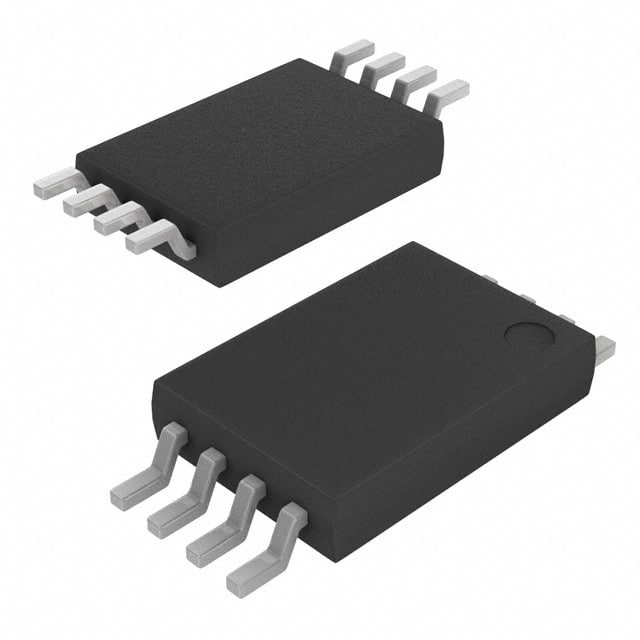Viz Specifikace pro podrobnosti o produktu.

Encyclopedia Entry: 93LC56B/ST
Product Overview
Category
The 93LC56B/ST belongs to the category of electrically erasable programmable read-only memory (EEPROM) chips.
Use
This chip is commonly used for non-volatile data storage in various electronic devices, such as microcontrollers, computers, and consumer electronics.
Characteristics
- Non-volatile: Retains stored data even when power is removed.
- Electrically erasable: Allows for easy modification of stored data.
- Programmable: Can be written and rewritten multiple times.
- Small form factor: Comes in a compact package suitable for integration into various electronic systems.
Package and Quantity
The 93LC56B/ST is typically packaged in a small surface-mount package, such as SOIC (Small Outline Integrated Circuit). It is available in different quantities per package, ranging from individual units to reels containing thousands of chips.
Specifications
- Memory capacity: 2 kilobits (256 bytes)
- Operating voltage: 2.5V to 5.5V
- Data retention: Up to 200 years
- Write endurance: Minimum 1 million write cycles
- Operating temperature range: -40°C to +85°C
Pin Configuration
The 93LC56B/ST chip has a standard pin configuration with eight pins. The following table provides a detailed description of each pin:
| Pin Number | Pin Name | Description | |------------|----------|-------------| | 1 | CS | Chip Select | | 2 | SK | Serial Clock | | 3 | DI | Data Input | | 4 | DO | Data Output | | 5 | VSS | Ground | | 6 | NC | No Connection | | 7 | VCC | Power Supply | | 8 | HOLD | Hold Input |
Functional Features
- Serial communication: The chip supports a serial interface for data transfer.
- Byte-level access: Allows reading and writing of individual bytes within the memory.
- Hardware write protection: Provides protection against accidental or unauthorized writes.
- Sequential read operation: Enables efficient retrieval of consecutive data bytes.
Advantages and Disadvantages
Advantages
- Non-volatile storage: Ensures data integrity even during power loss.
- Easy reprogramming: Allows for convenient modification of stored data.
- Compact size: Suitable for space-constrained electronic devices.
- High endurance: Can withstand a large number of write cycles.
Disadvantages
- Limited storage capacity: With only 2 kilobits, it may not be sufficient for certain applications requiring larger memory.
- Relatively slower write speed compared to other memory technologies.
Working Principles
The 93LC56B/ST utilizes an electrically erasable technology based on floating-gate transistors. It stores data by trapping charges in the floating gate, which can be removed or added through electrical signals. This allows for both erasing and programming of data in a non-volatile manner.
Application Field Plans
The 93LC56B/ST finds application in various fields, including: 1. Embedded systems: Used for storing configuration data and firmware updates in microcontrollers. 2. Automotive electronics: Employed for storing critical information like calibration data and vehicle settings. 3. Industrial automation: Utilized for storing parameters and log data in programmable logic controllers (PLCs). 4. Consumer electronics: Integrated into devices like smart TVs, set-top boxes, and gaming consoles for data storage purposes.
Alternative Models
For those seeking alternatives to the 93LC56B/ST, the following EEPROM chips can be considered: - 24LC256: Offers higher storage capacity of 32 kilobits. - AT24C02: Provides a lower-cost option with 2 kilobits capacity. - CAT24C04: Features an extended temperature range suitable for harsh environments.
In conclusion, the 93LC56B/ST is a versatile EEPROM chip that offers non-volatile data storage, easy reprogramming, and compact size. While it may have limitations in terms of storage capacity and write speed, its wide range of applications and availability of alternative models make it a valuable component in various electronic systems.
Word count: 560
Seznam 10 běžných otázek a odpovědí souvisejících s aplikací 93LC56B/ST v technických řešeních
Question: What is the maximum clock frequency for 93LC56B/ST?
Answer: The maximum clock frequency for 93LC56B/ST is 2 MHz.Question: What is the operating voltage range for 93LC56B/ST?
Answer: The operating voltage range for 93LC56B/ST is 2.5V to 5.5V.Question: Can 93LC56B/ST be used in automotive applications?
Answer: Yes, 93LC56B/ST is suitable for automotive applications.Question: What is the typical write cycle time for 93LC56B/ST?
Answer: The typical write cycle time for 93LC56B/ST is 5 ms.Question: Is 93LC56B/ST compatible with SPI interface?
Answer: Yes, 93LC56B/ST is compatible with SPI interface.Question: What is the temperature range for 93LC56B/ST?
Answer: The temperature range for 93LC56B/ST is -40°C to 125°C.Question: Can 93LC56B/ST be used in battery-powered devices?
Answer: Yes, 93LC56B/ST is suitable for use in battery-powered devices.Question: Does 93LC56B/ST support partial page writes?
Answer: Yes, 93LC56B/ST supports partial page writes.Question: What is the package type for 93LC56B/ST?
Answer: The package type for 93LC56B/ST is SOIC (8-pin).Question: Is 93LC56B/ST RoHS compliant?
Answer: Yes, 93LC56B/ST is RoHS compliant.

